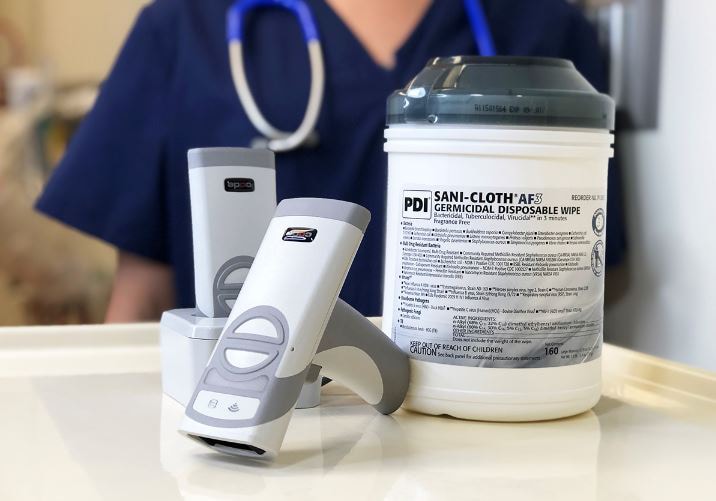March 31, 2020
Why Healthcare Facilities Need Easy-to-Clean Equipment
Disinfectants, cleaners and decontaminants are made of harsh chemicals, and some healthcare equipment doesn't hold up well to even one cleaning, let alone a daily routine.

The modern healthcare system features miraculousadvancements in technology, treatments and methods of healing. The equipmentused to diagnose and treat patients has changed radically in just the past 50years. Doctors now have the means of looking at the human body in ways thatcould only be imagined on Star Trek before. Every day, medical science brings healthcarefacilities closer to curing everything from cancer to the common cold.
Much of this advancement is a direct result of a greaterunderstanding of pathogens, contamination and proper sterilization techniques,some of which have only been around for the last 20 years. It's almost shockingto realize that much of our medical knowledge and understanding of healthcareprocedures is predicated on things we've learned in just the past few decades.
The good news is that we now have better sterilization andreduced contamination in hospitals and healthcare facilities as a result. Butin order to maintain these gains in quality care, medical facilities mustremain vigilant in their practices to protect against accidentally transferring,contaminating, or spreading bacterium,viruses or other microorganisms within their facility. Without promptattention to these issues, isolated cases can rapidly become major healthissues.
How cleaners and disinfectants can create issues with medical equipment
Decontaminants and disinfectants are used as part of the sterilization process when protecting the safety of hospitals, clinics, care centres and offices. Protocols developed by the Centers for Disease Control and Prevention established standards for ensuring that contamination isn't spread by people, equipment, instruments or materials used in medical facilities, standards which should be followed in every healthcare environment. These protocols help to keep patients safe and healthy during their visit, regardless of how long or short it may be.
However, disinfectants, cleaners and decontaminants are made of harsh chemicals, and some equipment and instruments don't hold up well to even one cleaning, let alone a daily routine and possibly multiple exposures to these compounds. Because of the costs associated with replacing this equipment, some healthcare professionals may be tempted to minimize sterilization practices. Unfortunately, this increases the risk of cross contamination. The resulting rise in health issues can lead to increased hospital stays, increased medications, possible surgical intervention or even patient deaths.
It's not surprising to learn that many pieces of equipmentfall victim to the liquids that are meant to help hospitals maintain a saferenvironment. They can be corrosive to plastic and metal alike, shortening equipmentlife span and increasing costs for the facility. Given the cost to replaceequipment that becomes compromised, finding a product resistant to the damagesof disinfectants and cleaners would be a real game-changer to those hospitalsand clinics.
Code CR2700: Builtspecifically for healthcare facilities
The CodeCR2700 is built specifically for the healthcare community and offers anumber of features that are ideal for healthcare facilities. Among theadvantages of the CR2700 are:
- Inductive charging, which means no exposed metal. This eliminates chemical corrosion caused by disinfectants and cleaners that can damage the charging pins.
- Bluetooth Low Energy 5 for enhanced data security, throughput and transmission range.
- Streamlined case eliminates hard-to-disinfect nooks and crannies.
PVC-Free CodeShield medical-grade plastics stand up to harsh disinfectants. - Lightweight, ergonomic models in palm and handled configurations.
- Durable, quick-release rechargeable battery cartridges save time.
- Smart battery shows battery health with a visible fuel gauge.
- Visual, audible and haptic indicator customization for workflow needs.
- Patented dual-field optics, both high density and wide field in the same unit, add versatility and function.
- Patented glare reduction technology means reading barcodes on shiny surfaces is no longer a challenge.
- High-speed, omnidirectional reading of all barcodes used in healthcare makes the process faster and more accurate.
- Multiple programmable buttons allow you to create customized workflow processes.
- Pair to Bluetooth-supported Android, iOS and Windows devices and tablets.
- IP65 rating seals out dust and moisture for longer product life.
- CortexRM Remote Management ready.
- Powerful data management capability with JavaScript.
- Code Complete service and extended warranty plans offer additional protection.
Being purpose-built for the healthcareenvironment, the CR2700 is an ideal fit for nurses, CNAs and healthcareprofessionals with varied workflows. Small enough to fit in scrub pockets, healthcareworkers can carry the CR2700 from room to room for point-of-care activitieslike patient verification and medication administration. The CodeShield plastichousing can withstand multiple cleaning and disinfecting rounds in a daywithout degradation of the materials.
Try the CR2700 for yourself for free and see how versatile it is and how it holds up to your most stringent disinfecting regimen. Contact your CDW Account Manager to schedule your free demo.
